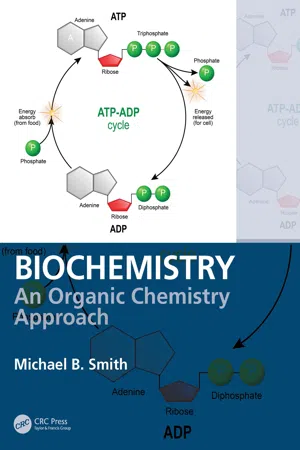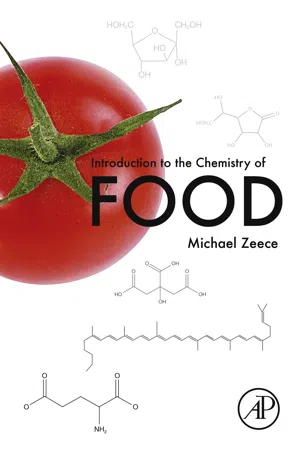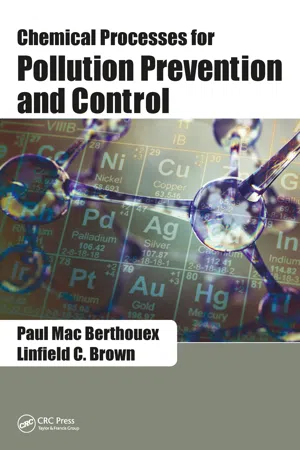Chemistry
pH and Solubility
pH and solubility are interconnected in chemistry. pH measures the acidity or basicity of a solution, affecting the solubility of different substances. Generally, acidic solutions increase the solubility of acidic compounds, while basic solutions increase the solubility of basic compounds. Understanding pH is crucial for predicting and controlling the solubility of substances in various chemical reactions.
Written by Perlego with AI-assistance
Related key terms
11 Key excerpts on "pH and Solubility"
- eBook - ePub
Biochemistry
An Organic Chemistry Approach
- Michael B. Smith(Author)
- 2020(Publication Date)
- CRC Press(Publisher)
– ], or 14.00 at 25 °C. While this definition is true in absolutely pure water, the ionization of pure water is rarely important whereas the ionization of solutions that have dissolved solutes must be considered. Solubility in blood is an example.This calculation will determine the percentage of a reactant that will precipitate at or below a certain pH.Blood has presumably the same ionic strength as normal saline (9 g/L NaCl) or μ = 0.15, but it is unlikely that the pKw is the same as in normal saline because blood serum also contains 8% of organic matter. The presence of this organic matter will change the structure, the concentration, and therefore the activity of the water in the serum.77 Hawkes, S.J. Journal of Chemical Education 1995 , 7 2, 799–802.Acid-base chemistry is quite important in biological systems. Indeed, acid-base reactions drive many common processes. One useful example of the acid-base equilibrium process is metabolic acidosis and metabolic alkalosis. The normal range for blood pH is 7.36–7.44. If the pH levels drop below 6.9, it can lead to coma. The body can generate acidic compounds that can change this pH, making blood or tissue more acidic as a result of the natural breakdown of fats. This statement is particularly true when fats are used for energy rather than carbohydrates (see Sections 8.3 and 8.5), although other processes can generate acids. Generated bicarbonate reacts as a base. If there is insufficient bicarbonate to compensate for the extra acid, acidosis can occur. Formally, acidosis is a significant decrease in pH of extracellular fluid.8 This condition can occur due to both respiratory and metabolic abnormalities. Respiratory acidosis occurs when breathing abnormalities result in CO2 retention and an elevation in P CO2 in alveoli and arterial blood (known as hypercapnia).8 The term P CO2 refers to the partial pressure of CO2 in the pulmonary alveoli during respiration.8 Retention of CO2 can result from inadequate ventilation during anesthesia, certain conditions that result from central nervous system (CNS) disease or from drug use, and it is observed with emphysema.8 Metabolic acidosis occurs with starvation, uncontrolled diabetes mellitus with ketosis, and with electrolyte and water loss due to diarrhea.8 - eBook - ePub
- Christoph Saal, Anita Nair(Authors)
- 2020(Publication Date)
- De Gruyter(Publisher)
max . At the early stages of drug discovery, high-throughput screening of solubility is usually carried out only at neutral pH, but it is important to know the pH dependence of solubility for estimating absorption as the solubility must be acceptable within the pH range of the gastrointestinal tract (between pH 1 and 8).The solubility–pH profile for a compound can be obtained by measuring the solubility at various pHs between 1 and 8, or by measuring the intrinsic solubility and the acid dissociation constant (pKa ) to estimate the lowest solubility value within the pH range of 1 and 8.The pH dependence of solubility of ionized compounds has been utilized by the recently introduced “chasing equilibrium method” (CheqSol) [21 ]. This method has the advantage that it is not necessary to wait until equilibrium is reached, as the precipitation is forced by changing the pH. Ionizable compounds turn to less soluble neutral forms. A known amount of solid compound should be accurately weighed and a known quantity of acid (HCl) for basic compounds or base (KOH) for acidic compounds is added until the solid compound is fully dissolved due to salt formation. Titrating the acidic or alkaline solution then started with a known amount and strength of base or acid until precipitation is detected due to the loss of ionization of the compound. The precipitation is detected using a spectroscopic dip probe. From the amount of the alkaline and acid solutions, one can calculate the exact pH when precipitation occurs. The kinetic solubility of the compound is derived from the pH at the point of precipitation. To calculate the equilibrium solubility of the compound, the sample is back titrated with an acid or base, until the compound starts to dissolve. Then additional aliquots of titrant are added to produce additional solid, after which the pH change is measured. The direction of the pH gradient upon precipitation gives an indication of the saturation level of the solution. For example, an unionized base precipitating from a super-saturated solution produces a negative pH gradient, contrary to an unionized base dissolving from a sub-saturated solution that produces a positive pH gradient. These changes of the sign of the pH gradient are used to determine the exact pH at which the solid is in equilibrium with the saturated solution. The concentration of the saturated solution, for example, the intrinsic solubility is calculated from the pH at equilibrium by applying the principles of mass and charge balance [22 ]. The advantage of this method is that it is not required to wait for 18–48 h to reach equilibrium between the solid and the saturated solution. There is no need to separate the solid material and use an analytical method to determine the concentration of the saturated solution. As the amount of solid used to start the experiment is exactly known, one knows precisely how many moles of acid or base are used to dissolve the compound and precipitate it out again. One can calculate how many moles are in solution at the time of precipitation. Another interesting observation has been made by using the CheqSol method: some compounds form super-saturated solutions very easily (“chasers”), while other compounds instantly precipitate out without super-saturation when the equilibrium has been achieved (“non-chasers”) [23 ]. Box et al. [24 - Gerald E. McDonnell, Denise Sheard(Authors)
- 2012(Publication Date)
- Wiley-Blackwell(Publisher)
a “gallon” in the US can be a dry or liquid gallon and both are different to the imperial gallon). The pH scale: defining acids and bases Chemists can use a variety of ways to study and analyse various different types of chemicals and solutions. One such measurement is known as pH, which is a measure of how acidic or alkaline a liquid or solution is. The strict chemical understanding of pH is that it is a measure of the hydrogen ion (H +) concentration in a solution, but this is not considered further. The pH scale ranges from 0 to 14 (Figure 6.5) and all liquids will fall somewhere on this scale. The mid-range of the scale is at 7, at which a liquid is considered “neutral”, while the more acidic the lower the number (“strong acid”) and the more alkaline (or basic) the higher the number (“strong alkali/base”). An example of a neutral liquid is drinking water (if it is correctly provided) which is generally in the neutral range (pH 6–8). Another is blood that is generally at and maintained at a pH of about 7.4 (this can also be referred to as being slightly alkaline). As liquids are measured to be more acidic (<6) or alkaline/basic (>8), they are considered more aggressive. Some common types of acids are vinegar (which is actually a dilute or watered-down version of an acid known as acetic acid, which has the chemical formula CH 3 COOH or also written as C 2 H 4 O 2), orange juice and lemon juice. Hydrochloric acid (HCl) is produced by the body in the stomach, which gives the stomach contents an acidic pH to aid in the digestive process (see Chapter 2). Examples of alkaline liquids are bleach solutions (a mixture of a chemical known as sodium hypochlorite, NaOCl, in water) and many liquid soaps and detergents. It should be noted that the difference, for example, between a solution of pH 6 and pH 5 is larger than it seems because it is what is referre d to as a “log” scale- eBook - ePub
Developing Solid Oral Dosage Forms
Pharmaceutical Theory and Practice
- Yihong Qiu, Yisheng Chen, Geoff G.Z. Zhang, Lawrence Yu, Rao V. Mantri(Authors)
- 2016(Publication Date)
- Academic Press(Publisher)
The solubility of drug candidates can be altered by modifying the crystal form or by changing solvent properties and conditions. As discussed in the previous sections, the equilibrium solubility is dependent on the properties and nature of interactions in solid state, as well as in solution state. Modifications in the solid state can be accomplished by the use of prodrugs, use of metastable crystal forms, or amorphous state of the drug, salt formation, or co-crystal formation. In solution state, the solubility can be influenced by altering solution pH (for ionizable drugs) or use of additives such as complexing agents, surfactants, or cosolvents. Orally administered drugs must undergo dissolution in the gastrointestinal tract (GI) prior to absorption across the intestinal epithelium. The dissolution rate is not only dependent on the physicochemical properties of the drug, but also the physiological conditions in the GI tract. The in vivo physiological conditions that influence the oral dissolution and solubilization include intestinal pH, GI transit time, bile salts, and lipid content. In the following sections, the impact of solvent pH (ie, drug ionization and salt formation), complexation, micellar solubilization by surfactants, cosolvency, and the combined effects of these factors on drug solubility will be discussed.1.4.1 Solubility enhancement by pH control and salt formation
A significant portion of drug candidates are weak acids, bases, and their salts.47 ,48As will be shown in the following sections, solubility of these compounds is dependent on the pH of the aqueous medium and the electrolytes in solution. The ionization equilibria and the intrinsic solubility of various unionized (free form) and ionized (salt form) species determine the nature of dependency of drug solubility on pH.1.4.1.1 Theoretical expressions to describe pH–solubility profiles
The pH-solubility profile of a monoprotic acid (HA) is obtained by the superposition of the two distinct pH-solubility curves for the free form and the salt form, with the constraint that the solubility of either species cannot be exceeded at a given pH (Fig. 1.2 ). This profile is obtained by following the solubility of free acid (HA) in solutions containing different amounts of a base (eg, MOH).Figure 1.2 pH solubility of free acid or its salt.The profile can be divided into two regions,48 In Region I, the free acid is present as the excess solid in equilibrium with the solution. The total solubility is the sum of concentrations of unionized (free acid) and the dissociated form:(1.39)S T=C HA+CA −(1.39)At equilibrium (saturation), the concentration of the free acid, C HA , is equal to its intrinsic solubility (S HA ). The concentration of the dissociated form,CA − - eBook - ePub
Chemistry
Concepts and Problems, A Self-Teaching Guide
- Richard Post, Chad Snyder, Clifford C. Houk(Authors)
- 2020(Publication Date)
- Jossey-Bass(Publisher)
The pH, sometimes called the “hydrogen ion exponent,” is defined mathematically as the negative logarithm to the base 10 of the hydrogen ion concentration. For the following H + ion concentrations, compare the power of 10 exponent with the corresponding value of pH. Answer: 6 If the hydrogen ion concentration is 1 × 10 –(exponent), then the pH is equal to the exponent. Or, expressed another way: If a solution has a pH of 3, what is the hydrogen ion concentration? _____ Answer: [H + ] = 1 × 10 −3 M What is the pH of pure neutral water? __________ Answer: A solution is acidic if [H + ] is greater than 1 × 10 −7 M. A solution is alkaline if [H + ] is less than 1 × 10 −7 M. Is a solution with a pH of 6 acidic or alkaline? __________ Answer: acidic (The [H + ] = 1 × 10 −6, which is greater than 1 × 10 −7.) To determine the pH of a solution if the [H + ] is something other than 1 × 10 –(exponent) requires use of common logarithms (log to the base 10). Some instructors may arrange problems so that all [H + ] will be 1 × 10 –(exponent) to simplify calculations. More often than not, [H + ] is something other than 1 × 10 –(exponent). We have chosen such examples and included a log table for your use in the Appendix. You may also use your scientific calculator or the handy calculators available on the Internet by way of a web browser and search engines. In this book, the answers to problems involving logarithms will assume you understand and know how to use logarithms. To determine the pH of a hydrogen ion concentration of n × 10 –(exponent), where n is a number other than 1, we must determine the logarithm of the number n. Determine the pH of a solution if [H + ] = 3 × 10 −5 (to the nearest hundredth) - eBook - ePub
- Michael Zeece(Author)
- 2020(Publication Date)
- Academic Press(Publisher)
Chapter OneChemical properties of water and pH
Abstract
This chapter describes the structure of water and the importance of hydrogen bonds to its physical and chemical properties. Water's high pointing point and surface tension result from extensive hydrogen bonding between molecules. The polar nature of water molecules determines the solubility of other substances, or lack thereof. Acid-base chemistry, pH, and their relevance to food are discussed. Chemical leavening, for example, employs acid-base chemistry to produce bread doughs that rise without yeast. The water content of food affects its texture and rate of spoilage. The concept of water activity and its importance to controlling spoilage, is described.Learning objectivesKeywords
Acid; Base; pH; Weak acid; Buffer; Ionization; Hydrogen bond; Titratable acidity; Dipole; Solute; Solubility; Sublimation; Surfactant; Colloid; Water activity; HumectantThis chapter will help you describe or explain:• Water’s structure• The hydrogen bond and its importance to water• What a food acid is, including examples• pH and titratable acidity• The importance of water to food color, taste, and texture• Why oil is not soluble in water• Water activity and its importance to food quality and safetyIntroduction
Water is the major component of all living things and therefore an important part of food. Water affects the texture, taste, color, and microbial safety of everything we eat. The moisture content of food is a good indicator of its texture. In general, it equates with a softer food texture. For example, the texture of yogurt, meat, bread, and hard candy decreases in that order and parallels the respective moisture content of these foods. Water is the vehicle that carries taste molecules to receptors in the mouth. For example, the sweetness of cherries, bitterness of beer, sourness of lemons, saltiness of pretzels, and pungency of peppers results from compounds (tastants) dissolved in water. The method of cooking (wet or dry) affects food flavor and color. Food cooked using wet methods, such as boiling, are generally low in flavor and color. In contrast, foods cooked with dry methods, such as frying or grilling have greater flavor and color. The moisture content of foods, such as milk, is directly related to its potential for microbial spoilage. Control of water available to spoilage organisms can be accomplished by lowering the food's water activity level (aw - eBook - ePub
- Odd-Ivar Lekang(Author)
- 2019(Publication Date)
- Wiley-Blackwell(Publisher)
75.2 pH
5.2.1 Water dissolves in water
Water is a substance that can be both an acid and a base because it dissolves in water (own proteolysis). This means pure water does not contain only water (H2 O) but also H+ and OH− ions given by the following equilibrium:Correctly shall the equation below be used but it is typically shown simplified as the equation above:The dissociation constant Kd of the equation gives the amount that is dissociated in relation to the amount of non‐dissociated form:The dissociation constant is temperature dependent. The reason for the temperature dependency is that dissolving water is an endothermic reaction, meaning it absorbs heat. When the temperature increases, the system will try to stay in equilibrium, which means using more energy to dissociate. This means that more ions will be created by higher temperature because this absorbs energy (le Chatelier's principle), and the Kd value will therefore increase.At 25 °C the dissociation is 2.16 × 10−16 , meaning that only a very limited part of the water dissociates into H+ and OH− .Pure water will be a solution of water (H2 O) and dissociated ions (H+ and OH− ). The concentration of the solution is measured in mol/L (or molar(M)), and gives the number of water molecules (H2 O) per litre. The ions (H+ and OH− - eBook - ePub
Soil Science
Methods & Applications
- David L. Rowell(Author)
- 2014(Publication Date)
- Routledge(Publisher)
Section 8.1 explains the terms involved. It should be noted that when applied to soils, ‘neutral’ is given a slightly different meaning, being a range from about pH 6.5 to 7.Soil acidity involves more than just the pH of the soil solution. This is still the main principle and the measurement of soil pH (Section 8.1 ) is normally made in a suspension of soil in water such that the value obtained is primarily related to the solution pH. However, hydrogen ions are also present on cation exchange sites and have an effect on the measurement. Also as soils become more acidic (pH 7 → 3), there are associated changes in the following properties:• The amounts of exchangeable Ca2+ and Mg2+ decrease. These together with exchangeable K+ , Na2+ and are known as the basic cations: their total amount is often expressed as a percentage of the CEC which is termed the percentage base saturation (Section 8.2 ).• The amount of exchangeable Al3+ increases and is often expressed as the percentage aluminium saturation of the ECEC (Section 8.2 ).• The negative charge on humus decreases and the positive charge on sesquioxides increases (Sections 7.1 and 7.5 ).• The availability of plant nutrients is changed. For example, phosphate solubility is reduced (Ch. 10 ).• The availability of toxic elements is changed. For example, aluminium and manganese become more soluble in acid soils (Section 8.3 ).• The activity of many soil organisms is reduced resulting in an accumulation of organic matter, reduced mineralization and a lower availability of N, P and S. THE DEVELOPMENT OF SOIL ACIDITYIn pure water the concentration of H+ ions is 10−7 mol 1−1 and the pH is 7. When in contact with the atmospheric concentration of CO2 a dilute carbonic acid solution is formed with a pH of 5.6. Distilled or deionized water in the laboratory therefore has a pH of about 5.6. For the pH to differ from this value some other acid or base must be present. Thus ‘acid rain’ contains nitric and sulphuric acid dissolved from the atmosphere (or ammonia and oxides of N and S which can form these acids). Its pH is below 5.6; the average pH of rain over eastern Britain is about 4.4 (DOE, 1990). Even in unpolluted air rain picks up small amounts of naturally occurring acid and has a pH of about 5. Ammonia and oxides of N and S are also deposited dry on vegetation and soil and are washed into the soil by rain where they produce acidity. Thus the atmosphere is an external source of acidity (Fig. 8.1 - eBook - ePub
- Detlev Möller(Author)
- 2015(Publication Date)
- De Gruyter(Publisher)
solvation , i.e. the dissolved molecule becomes surrounded by solvent molecules:The index (aq) also often includes that the species is hydrated (solvated by H2 O). Additionally, the solubility can be increased by complexation (see Chapter 3.2.2.7). Solubility quantifies the dynamic equilibrium state (Equation (3.64) ) achieved when the rate of dissolution equals the rate of precipitation . The solubility depends on temperature. It can be derived in a similar equation as for evaporation (Equation (3.50) ) where solvation enthalpy for indefinite dilution:If the saturation concentration is exceeded (for example by changing T and pH), the solute precipitates and forms a solid precipitate (or sediment ). Salts dissociate (the charge is here not important for describing the solubility and therefore not regarded, see Equation (3.44) ):The equilibrium is described by (see Chapter 3.2.2.1):The term [AB]s denotes the concentration of AB in the pure substance AB and is therefore constant (e.g. dimension in mol per litre or kilogram). We define a solubility product constant K sp and can write:K sp = [A]α [B]β = K diss [Aα Bβ ] . (3.68)The T dependency in the case of electrolytes is now given by (see Equation (3.56) ):Note that in Equation (3.67) and Equation (3.68) instead of concentration c , activity a (see Chapter 3.1.2.4) must be used more exactly. However, in the case of diluted solutions and difficultly soluble substances (e.g. SiO2 , CaCO3 - Paul Mac Berthouex, Linfield C. Brown(Authors)
- 2017(Publication Date)
- CRC Press(Publisher)
− ], and vice versa. For example,[H+ ] = 10−2 and [OH− ] = 10−12[H+ ] = 10−3 and [OH− ] = 10−11[H+ ] = 10−9 and [OH− ] = 10−5where [H+ ] = hydrogen ion concentration (mol/L)[OH− ] = hydroxyl ion concentration (mol/L)KWis temperature dependent, as shown in Table 7.1 .TABLE 7.1The Ionization of Water (KW) Is a Function of Temperature7.4 pH
pH is a fundamental characteristic of chemical solutions. It determines the extent of ionization of soluble compounds and the formation of solids by ions that tend to precipitate. Low pH indicates acidic conditions.The definition of pH ispH = −log10 [H+ ]This convenient “p” notation saves us having to write the concentrations as exponentials. The “p” comes from “potential,” and the formula −log10 [X ] is used in other cases where logarithmic values are easier to understand.Taking negative logarithms of the equilibrium expression for water,
The pH scale for aqueous solutions runs from 0 to 14. A change of one pH unit represents a 10-fold change in [H+].KW= [H+ ][OH− ] = 10−14gives −log10KW= −log10 [H+ ]−log10 [OH− ] = 14and pKW= pH + pOH = 14At pH = 2 [H+] = 10−2 and [OH− ] = 10−12pH = 3 [H+ ] = 10−3 and [OH− ] = 10−11pH = 9 [H+ ] = 10−9 and [OH− ] = 10−5Table 7.2 shows howKWand the neutral pH depend on temperature. Even though the pH of pure water changes with temperature, it is still neutral. In pure water, there will always be the same number of hydrogen ions and hydroxide ions. That means that the pure water remains neutral even if its pH changes.We are strongly conditioned to the idea of 7 being the pH of pure water, and anything else feels strange. Remember that if the value ofKW- eBook - ePub
- Jeffrey Gaffney, Nancy Marley(Authors)
- 2017(Publication Date)
- Elsevier(Publisher)
+ ]. Although theoretically the pH scale is open-ended, most pH values fall in the range from 0 to 14.Table 5.3 Molar Hydronium and Hydroxide Ion Concentrations for pH Values From 0 to 14pH [H+ ] [OH− ] 0 1.0 0.00000000000001 1 0.1 0.0000000000001 2 0.01 0.000000000001 3 0.001 0.00000000001 4 0.0001 0.0000000001 5 0.00001 0.000000001 6 0.000001 0.00000001 7 0.0000001 0.0000001 8 0.00000001 0.000001 9 0.000000001 0.00001 10 0.0000000001 0.0001 11 0.00000000001 0.001 12 0.000000000001 0.01 13 0.0000000000001 0.1 14 0.00000000000001 1.0 The pH of pure water at 25°C can be calculated from the concentration of [H3 O+ ] in pure water, which is equal to 1.0 × 10− 7 M.pH = − log1 ×= −10− 7log 1.0 + log= −10− 70 += 7.00− 7Acidic solutions will have a higher [H3 O+ ] than pure water (values > 1 × 10− 7 ). So, the pH values of acidic solutions will be less than 7.0. Since basic solutions will have a lower concentration of [H3 O+ ] than pure water (values < 1 × 10− 7 ), the pH values of basic solutions will be greater than 7.0. The lower the pH value, the higher the hydronium ion concentration and the stronger the acid solution. Similarly, the higher the pH value, the lower the hydronium ion concentration and the stronger the basic solution (Fig. 5.6 ).Fig. 5.6
Index pages curate the most relevant extracts from our library of academic textbooks. They’ve been created using an in-house natural language model (NLM), each adding context and meaning to key research topics.










